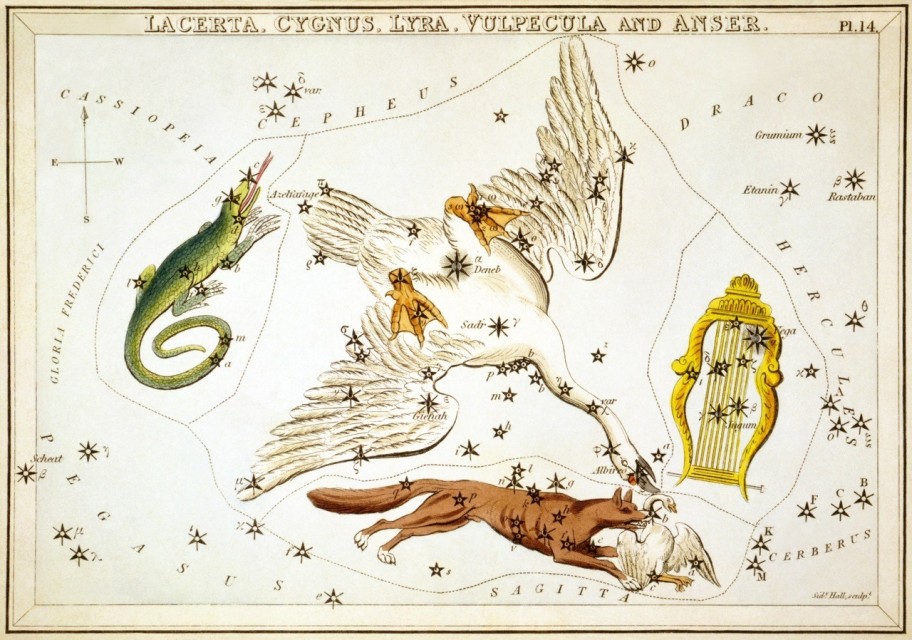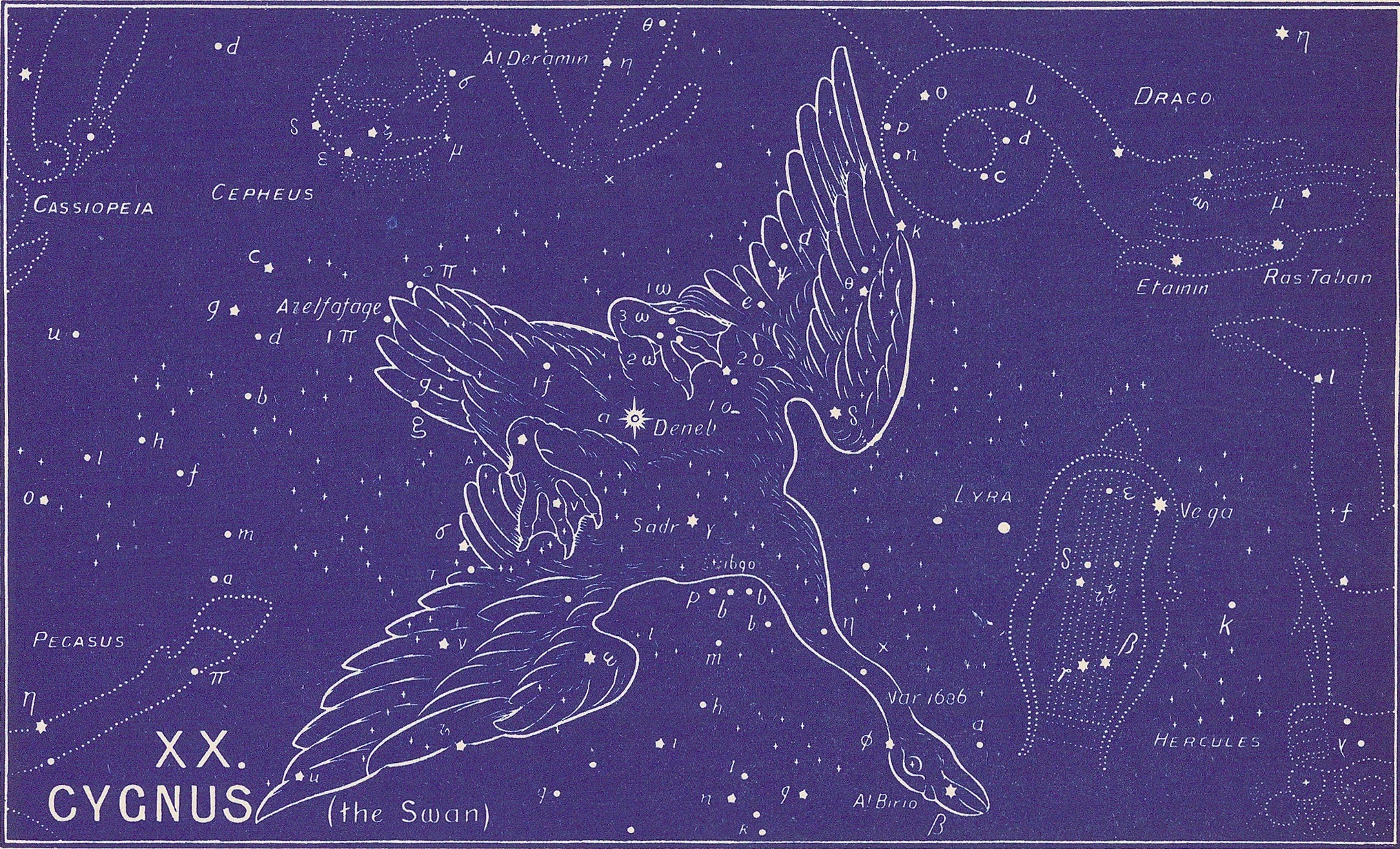FIXED STARS: Major Stars | 1000+ Stars | Constellations | About
Constellation Cygnus the Swan is a northern constellation bordering Draco and Pegasus. It is one of the 48 constellations listed by Ptolemy in the 2nd century and remains one of the 88 modern constellations. Cygnus spans 60 degrees of the zodiac in the Signs of Aquarius and Pisces.Cygnus Constellation Stars
| 2000 | 2050 | Star | Name | Sp. Class | Mag. | Orb |
|---|---|---|---|---|---|---|
| 01♒15 | 01♒56 | β Cyg | Albireo | K3 | 2.90 | 1°50′ |
| 12♒55 | 13♒37 | η Cyg | K0 | 3.89 | 1°30′ | |
| 14♒54 | 15♒36 | κ Cyg | Fawaris I | K0 | 3.80 | 1°30′ |
| 16♒14 | 16♒56 | δ Cyg | Fawaris II | B9 | 2.86 | 2°00′ |
| 17♒58 | 18♒39 | ι Cyg | A5 | 3.76 | 1°30′ | |
| 24♒50 | 25♒32 | γ Cyg | Sadr | F8 | 2.23 | 2°10′ |
| 27♒43 | 28♒27 | ε Cyg | Aljanah | K0 | 2.48 | 2°10′ |
| 28♒03 | 28♒45 | ο1 Cyg | K2 | 3.80 | 1°30′ | |
| 29♒47 | 00♓28 | ο2 Cyg | K3 | 3.96 | 1°30′ | |
| 03♓02 | 03♓46 | ζ Cyg | Fawaris III | G8 | 3.21 | 1°50′ |
| 05♓19 | 06♓01 | α Cyg | Deneb Adige | A2 | 1.25 | 2°30′ |
| 06♓00 | 06♓42 | ω1 Cyg | Ruchba | B2 | 4.94 | 1°00′ |
| 06♓08 | 06♓50 | ν Cyg | A1 | 3.94 | 1°30′ | |
| 08♓19 | 09♓18 | τ Cyg | F1 | 3.74 | 1°30′ | |
| 10♓48 | 11♓29 | ξ Cyg | K5 | 3.72 | 1°30′ | |
| 20♓08 | 20♓50 | ρ Cyg | G8 | 3.98 | 1°30′ | |
| 27♓11 | 27♓52 | π2 Cyg | Pennae Caudalis | B3 | 4.23 | 1°20′ |
| 28♓16 | 28♓58 | π1 Cyg | Azelfafage | B3 | 4.69 | 1°00′ |
Cygnus Astrology
Manilius
Hard by is the place allotted to the Swan: as a reward for the shape with which he [Zeus] snared the admiring Leda, when, a god changed into a snow-white swan, he came down and offered his feathered form to the unsuspecting woman. Now too with outspread wings it flies among the stars.
Its down and glittering wings figured by stars. Accordingly he who at its rising leaves his mother’s womb and beholds the light of day shall make the denizens of the air and the race of birds that is dedicated to heaven the source of his pleasure and profit.
From this constellation shall flow a thousand human skills: its child will declare war on heaven and catch a bird in mid-flight, or he will rob it of its nestling, or draw nets up and over a bird whilst it is perched on a branch or feeds on the ground. And the object of these skills is to satisfy our high living. Today we go farther afield for the stomach than we used to go for war: we are fed from the shores of Numidia and the groves of Phasis; our markets are stocked from the land whence over a new-discovered sea was carried off the Golden Fleece. Nay more, such a man will impart to the birds of the air the language of men and what words mean; he will introduce them to a new kind of intercourse, teaching them the speech denied them by nature’s law.
In its own person the Swan hides a god and the voice belonging to it; it is more than a bird and mutters to itself within. Fail not to mark the men who delight to feed the birds of Venus in pens on a rooftop, releasing them to their native skies or recalling them by special signs; or those who carry in cages throughout the city birds taught to obey words of command, men whose total wealth consists of a little sparrow. [1]
Robson
Legend. In order to visit Leda, the wife of Tyndareus, the King of Sparta, with whom he was in love, Jupiter turned himself intp a swan and being persued by Venus in the shape of an eagle flew to Leda as if for protection.
Influence. Cygnus gives a contemplative, dreamy, cultured and adaptable nature. The affections are ill regulated and unsteady, the talents develop late. There is some love of water and swimming and the arts. By the Kabalists it is associated with the Hebrew letter Resh and the 20th Tarot Trump “Judgment”.
Magical. Frees from Palsy and the quartan plague. [2]
Noonan
Today called Cygnus (Cyg), in classical times was a dreaded constellation hostile to all things in the air. Ptolemy gives its stars the nature of Venus and Mercury. This is consistent with the spectra of Deneb (Venus) and Sador (Mercury), but both Albireo and Gienah have a Martian nature. Azelfafage (π1-Cyg) is not included in the ancient catalogs. Its magnitude is 4.8 and is spectra is type B3. [3]
Allen
Cygnus, the Swan, lies between Draco and Pegasus…. It was Κύκνος with Eratosthenes, but usually Ὄρνις with other Greeks, by which was simply intended a Bird of some kind, more particularly a Hen.
When the Romans adopted the title that we now have, our constellation became the mythical swan identified with Cycnus, the son of Mars, or of the Ligurian Sthenelus; or the brother of Phaëthon, transformed at the river Padus and transported to the sky. Associated, too, with Leda, the friend of Jupiter and mother of Castor, Pollux, and Helena, it was classed among the Argonautic constellations.
Our Cygnus may have originated on the Euphrates, for the tablets show a stellar bird of some kind, perhaps Urakhga, the original of the Arabs’ Rukh, the Roc, that Sindbad the Sailor knew. At all events, its present figuring did not originate with the Greeks, for the history of the constellation had been entirely lost to them, as had that of the mysterious Engonasin (Hercules), — an evident proof that they were not the inventors of at least some of the star-groups attributed to them.
In Arabia, although occasionally known as Al Ṭā’ir al Ardūf, the Flying Eagle, Chilmead’s Altayr, or as Al Radīf, it usually was Al Dajājah, the Hen, and appears as such even with the Egyptian priest Manetho, about 300 B.C., this degenerating into the Adige, Adigege, Aldigaga, Addigagato, Degige, Edegiagith, Eldigiagich, etc., of early lists, some of these even now applied to its brightest star.
Scaliger’s Al Ridhadh, for the constellation, which degenerated to El Rided, perhaps is the origin of our Arided for the lucida (Alpha star, Deneb Adige), but its signification is uncertain.
Argelander locates 146 naked-eye members of the constellation, and Heis 197, its situation in the Galaxy accounting for this density. Of these stars Espin gives a list of one hundred that are double, triple, or multiple. The Lace-work Nebula, NGC 6960, also lies within its borders. [4]
Bullinger
In the Denderah Zodiac it is named Tes-ark, which means this from afar. It is a most brilliant and gorgeous asterism of 81 stars; one of the 1st or 2nd, six of the 3rd, twelve of the 4th magnitude, etc. It contains variable stars, five double stars, and one quadruple. The star marked “61 Cygni” is known as one of the most wonderful in the whole heavens. It consists of two stars which revolve about each other, and yet have a progressive motion common to each!
This mighty bird is not falling dead, like Aquila, but it is flying swiftly in mid-heaven. It is coming to the earth, for it is not so much a bird of the air, but a bird peculiarly belonging to both the earth and the waters.
Its brightest star α (between the body and the tail), is called Deneb (like another in CAPRICORNUS), and means the judge. It is also called Adige, flying swiftly, and thus at once it is connected with Him who cometh to judge the earth in righteousness. The star β (in the beak) is named Al Bireo (Arabic), flying quickly. The star γ (in the body) is called Sadr (Hebrew), who returns as in a circle. The two stars in the tail, now marked in the maps as p I and p II, are named Azel, who goes and returns quickly; and Fafage, gloriously shining forth. [5]
References
- Astronomica, Manilius, 1st century AD, book 1, p.31, book 5, p.331.
- Fixed Stars and Constellations in Astrology, Vivian E. Robson, 1923, p.42, 231.
- Fixed Stars and Judicial Astrology, George Noonan, 1990, p.18.
- Star Names: Their Lore and Meaning, Richard H. Allen, 1889, p.192-198.
- The Witness of the Stars, E. W. Bullinger, 1893 Cygnus (the Swan).


